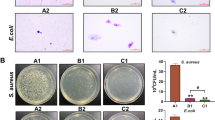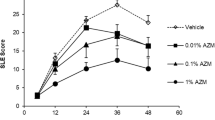Abstract
The aim of this study was to investigate antioxidant, anti-inflammatory, and antibacterial properties of propolis in the treatment of experimental Staphylococcus aureus keratitis. Twenty young New Zealand white rabbits were used in this experiment. Staphylococcus aureus were given by intrastromal injection to 16 rabbits and 4 rabbits were used as control group (Group 1). Group 2 was treated with phosphate-buffered solution drops; Group 3 was administered ethanolic extract of propolis drops; Group 4 received topical ciprofloxacin drops; Group 5 was treated with topical ciprofloxacin drops along with ethanolic extract of propolis drops. The eyes were examined by slit lamp to assess corneal opacity. And then, corneas were removed to determine nitric oxide (NO) levels and count bacteria. Corneas were also evaluated histologically. Corneal NO concentration in gruop 5, treated with a combination of propolis and ciprofloxacin was determined significantly lower (10.0± 1.8 μmol/g wet tissue) than in Group 4, treated with ciprofloxacin (24.0± 3.1 μmol/g wet tissue), from Group 3, treated with propolis (15.6± 1.8 μmol/g wet tissue), and treated with PBS (44.7± 7.8 μmol/g wet tissue). There were significantly fewer bacteria in eyes that received propolis plus ciprofloxacin than in eyes treated with ciprofloxacin (p = 0.0001) or propolis (p = 0.0001) or eyes treated with PBS (p = 0.0001). The light microscopic examination revealed that the control group showed normal corneal morphology. In the nontreated group, sections of the stromal infiltration revealed the presence of inflammatory cells, which were diffusely distributed (p < 0.05). Administrations of ciprofloxacin plus propolis resulted in a significantly reduced histological damage with fewer bacterial inoculation of the corneal stroma in comparison with the other groups (p < 0.05). Based on these findings, we suggest that ethanolic extract of propolis has antioxidant, anti-inflammatory, and antibacterial properties for S. aureus keratitis in rabbits.
Similar content being viewed by others
References
Alexandrakis G, Alfonso EC, Miller D: Shifting trends in bacterial keratitis in south Florida and emerging resistance to fluoroquinolones. Ophthalmology 107: 1497–1502, 2000
Liesegang TJ: Bacterial and fungal keratitis. In: H. E. Kaufman (ed). The Cornea, 2nd edn. Butterworth-Heinemann, Boston, MA, 1998, pp. 159–219
Boston MA, Callegan MC, Engel LS, Hill JM, O'Callaghan RJ: Corneal virulence of Staphylococcus aureus: Roles of alpha-toxin and protein A in pathogenesis. Infect Immun 62: 2478–2482, 1994
Trinkaus-Randall V, Leibowitz HM, Ryan WJ, Kupferman A: Quantificationof stromal destruction in the inflamed cornea. Invest Ophthalmol Vis Sci 32: 603–609, 1991
Leibowitz HM, Ryan WJ, Kupferman A, DeSantis L: Effect of concurrent topical corticosteroid and NSAID therapy of experimental keratitis. Invest Ophthalmol Vis Sci 27: 1226–1229, 1986
Wilhelmus KR, Stulting RD, Sugar J, Khan MM: Primary corneal graft failure. A national reporting system. Medical Advisory Board of the Eye Bank Association of America. Arch Ophthalmol 113(12): 1497–1502, 1995
Goureau O, Bellot J, Thillaye B, Courtois Y, de Kozak Y: Increased nitric oxide production in endotoxin-induced uveitis: Reduction of uveitis by an inhibitor of nitric oxide synthase. J Immunol 154: 6518–6523, 1995
Mandai M, Mittag TW, Kogishi J, Iwaki M, Hangai M, Yoshimura N: Role of nitric oxide synthase isozymes in endotoxin-induced uveitis. Invest Ophthalmol Vis Sci 37: 826–832, 1996
Moncada S, Palmer RMJ, Higgs EA: Nitric oxide: physiology, pathophysiology and pharmacology. Pharmacol Rev 43: 109–141, 1991
Knowles RG, Moncada S: Nitric oxide synthase in mammals. Biochem J 298: 249–258, 1994
Kröncke KD, Fehsel K, Kolb-Bachofen V: Inducible nitric oxide synthase and its product nitric oxide, a small molecule with complex biological activities. Biol Chem Hoppe-Seyler 376: 327–343, 1995
De Castro SL: Propolis: biological and pharmacological activities. Therapeutic uses of this bee-product. Annu Rev Biol Sci 3: 49–83, 2001
Banskota AH, Tezuka Y, Kadota S: Recent progress in pharmacological research of propolis Phytother Res 15: 561–571, 2001
Dobrowolski JW, Vohora SB, Sharma K, Shah SA, Naqvi SA, Dandiya PC: Antibacterial, antifungal, antiamoebic, anti-inflammatory, and antipyretic studies on propolis bee products. J Ethnopharmacol 35: 77–82, 1991
Khayyal MT, el-Ghazaly MA, el-Khatip AS: Mechanisms involved in the anti-inflammatory effect of propolis extract. Drugs Exp Clin Res 19: 197–203, 1993
Bankova VS, de Castro SL, Marcucci MC: Propolis: Recent advances in chemistry and plant origin. Apidologie 31: 3–15, 2000
Song YS, Park EH, Hur GM, Ryu YS, Lee YS, Lee JY, Kim YM, Jin C: Caffeic acid phenethyl ester inhibits nitric oxide synthase gene expression and enzyme activity. Cancer Lett 175: 53–61, 2002
National Committee for Clinical Laboratory Standards (NCCLS): Methods for dilution antimicrobial susceptibility tests for bacteria that grow aerobically. Approved Standard M7-A4, Viallanova, PA, 1997
Beisel KW, Hazlett LD, Berk RS: Dominant susceptibility effect on the murine corneal response to Pseudomonas aeruginosa. Proc Soc Exp Med 172: 488–491, 1983
Cortas NK, Wakid NW: Determination of inorganic nitrate in serum and urine by a kinetic cadmium-reduction metod. Clin Chem 36: 1440–1443, 1990
Chusid MJ, Davis SD: Experimental keratitis in neutropenic guinea pigs: Polymorphonuclear leukoytes in corneal host defense. Infect Immun 24: 948–952, 1979
Vajpayee RB, Sharma N, Chand M, Tabin GC, Vajpayee M, Anand JR: Corneal superinfection in acute hemorrhagic conjunctivitis. Cornea 17: 614–617, 1998
Elgebaly SA, Miano DC, Kreutzer DL, Fishman JB: Cornea derived neutrophil chemotactic factors: Intracellular synthesis and release. Curr Eye Res 9: 839–845, 1990
MacMicking J, Xie Q, Nathan C: Nitric oxide and macrophage function. Ann Rev Immunol 15: 323–350, 1997
Mandai M, Yoshimura N, Yoshida M, Iwaki M, Honda Y: The role of nitric oxide synthase in endotoxin-induced uveitis: Effects of NG-nitro l-arginine. Invest Ophthalmol Vis Sci 35: 3673–3679, 1994
Croen K: Evidence for an antiviral effect of nitric oxide J Clin Invest 91: 2446–2452, 1993
Bredt DS, Snyder SH: Nitric oxide: a physiological messenger molecule. Ann Rev Biochem 63: 175–195, 1994
Geyer O, Almong J, Lupu-Meiri M: Nitric oxide synthase inhibitors protect rat retina against ischemic injury. FEBS Lett 374: 399–402, 1995
Nathanson JA, Mckee M: Alternation of human nitric oxide synthase in human glaucoma Invest Ophthalmol Vis Sci 36: 1774–1784, 1995
Courtois BY, Goureau O: Nitric oxide in the eye: Multifaceted roles and diverse outcomes Surv Ophthalmol 42: 71–82, 1997
Castaldo S, Capasso F: Propolis, an old remedy used in modern medicine. Fitoterapia 73: S1–S6, 2002
Pascual C, Gonzalez R, Torricella RG: Scavenging action of propolis extract against oxygen radicals. J Ethnopharmacol 41: 9–13, 1994
Ichikawa H, Satoh K, Tobe T, Yasuda I, Ushio F, Matsumoto K, Endo K, Ookubo C: Free radical scavenging activity of propolis. Redox Rep 7: 347–350, 2002
Krol W, Scheller S, Czuba Z, Matsuno T, Zydowicz G, Shani J, Mos M: Inhibition of neutrophils chemiluminescence by ethanolic extract of propolis (EEP) and its phenolic components. J Ethnopharmacol 55: 19–25, 1996
Strehl E, Volpert R, Elstner EF: Biochemical activities of propolis extracts: III Inhibition of dehydrofolate reductase. Z Naturforsch 49: 39–43, 1994
Callegan MC, Hobden JA, Hill JM, Insler MS, O'Callaghan RJ: Topical antibiotic therapy for the treatment of experimental Staphylococcus aureus keratitis. Invest Ophthalmol Vis Sci 33: 3017–3023, 1992
Huang Y, Meek KM, Ho MW, Paterson CA: Anaylsis of birefringence during wound healing and remodeling following alkali burns in rabbit cornea. Exp Eye Res 73: 521–532, 2001
Oksuz H, Duran N, Koc A, Tamer C, Akaydı n Y, Cetin M, Silici S: Effect of propolis for treatment of experimental Staphylococcus aureus keratitis in rabbits. Ophthalmic Res (in press)
Author information
Authors and Affiliations
Corresponding author
Rights and permissions
About this article
Cite this article
Duran, N., Koc, A., Oksuz, H. et al. The protective role of topical propolis on experimental keratitis via nitric oxide levels in rabbits. Mol Cell Biochem 281, 153–161 (2006). https://doi.org/10.1007/s11010-006-0720-4
Received:
Accepted:
Issue Date:
DOI: https://doi.org/10.1007/s11010-006-0720-4




